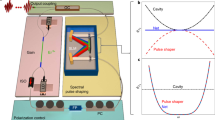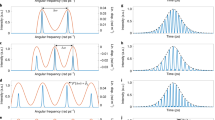Abstract
The ability to slow down and delay optical pulses is an intriguing physical phenomenon with significant applications, such as in telecommunications. It is essential for these applications that the phenomenon has enough bandwidth, so that it can respond sufficiently fast to the very short light pulses that will carry the information in future telecommunications systems. However, typical slow-light systems exhibit dispersion, which distorts the pulses on propagation, leading to loss of information, thereby limiting the bandwidth. This limitation imposes a trade-off between the acquired delay and the system’s bandwidth. By introducing nonlinearity, however, the pulse can travel slowly and also remain undistorted over arbitrarily long propagation lengths by the formation of a soliton. We observe such solitons in a fibre Bragg grating, and show that subnanosecond pulses travel at 16% of the speed of light, without broadening.
This is a preview of subscription content, access via your institution
Access options
Subscribe to this journal
Receive 12 print issues and online access
$209.00 per year
only $17.42 per issue
Buy this article
- Purchase on Springer Link
- Instant access to full article PDF
Prices may be subject to local taxes which are calculated during checkout







Similar content being viewed by others
References
Hau, L. V., Harris, S. E., Dutton, Z. & Behroozi, C. H. Light speed reduction to 17 metre per second in an ultracold atomic gas. Nature 397, 594–598 (1999).
Palinginis, P., Sedgwick, F., Crankshaw, S., Moewe, M. & Chang-Hasnain, C. J. Room temperature slow light in a quantum-well waveguide via coherent population oscillation. Opt. Express 13, 9909–9915 (2005).
Okawachi, Y. et al. Tunable all-optical delays via Brillouin slow light in an optical fiber. Phys. Rev. Lett. 94, 153902 (2005).
Song, K. Y., Herráez, M. G. & Thévenaz, L. Observation of pulse delaying and advancement in optical fibers using stimulated Brillouin scattering. Opt. Express 13, 82–88 (2005).
Longhi, S. et al. Optical buffering in phase-shifted fibre gratings. Electron. Lett. 41, 1075–1077 (2005).
Mok, J. T., Littler, I. C. M. & Eggleton, B. J. OSA Topical Meeting on Bragg Grating, Poling and Photosensitivity (BGPP) Sydney (2005).
Heebner, J. E., Wong, V., Schweinsberg, A., Boyd, R. W. & Jackson, D. J. Optical transmission characteristics of fiber ring resonators. IEEE J. Quantum Electron. 40, 726–730 (2004).
Poon, J. K. S., Zhu, L., DeRose, G. A. & Yariv, A. Transmission and group delay of microring coupled-resonator optical waveguides. Opt. Lett. 31, 456–458 (2006).
Letartre, X. et al. Group velocity and propagation losses measurement in a single-line photonic-crystal waveguide on InP membranes. Appl. Phys. Lett. 79, 2312–2314 (2001).
Mori, D. & Baba, T. Dispersion-controlled optical group delay device by chirped photonic crystal waveguides. Appl. Phys. Lett. 85, 1101–1103 (2004).
Gersen, H. et al. Real-space observation of ultraslow light in photonic crystal waveguides. Phys. Rev. Lett. 94, 073903 (2005).
Vlasov, Y. A., O’Boyle, M., Hamann, H. F. & McNab, S. J. Active control of slow light on a chip with photonic crystal waveguides. Nature 438, 65–69 (2005).
Altug, H. & Vuckovic, J. Experimental demonstration of the slow group velocity of light in two-dimensional coupled photonic crystal microcavity arrays. Appl. Phys. Lett. 86, 111102 (2005).
Boyd, R. & Gauthier, D. in Prog. in Optics Vol 43 (ed. Wolf, E.) 497–530 (Elsevier, Amsterdam, 2002).
Lenz, G., Eggleton, B. J., Madsen, C. K. & Slusher, R. E. Optical delay lines based on optical filters. J. Quantum Electron. 37, 525–530 (2001).
Yanik, M. F. & Fan, S. Stopping light all optically. Phys. Rev. Lett. 92, 083901 (2004).
Boyd, R. W., Gauthier, D. J., Gaeta, A. L. & Willner, A. E. Maximum time delay achievable on propagation through a slow-light medium. Phys. Rev. A 71, 02381 (2005).
Povinelli, M. L., Johnson, S. G. & Joannopoulos, J. D. Slow-light, band-edge waveguides for tunable time delays. Opt. Express 13, 7145–7159 (2005).
Khurgin, J. B. Expanding the bandwidth of slow-light photonic devices based on coupled resonators. Opt. Lett. 30, 513–515 (2005).
Sandhu, S., Povinelli, M. L., Yanik, M. F. & Fan, S. Dynamically tuned coupled-resonator delay lines can be nearly dispersion free. Opt. Lett. 31, 1985–1987 (2006).
Mok, J. T. & Eggleton, B. J. Expect more delays. Nature 433, 811–812 (2005).
Kashyap, R. Fiber Bragg Gratings (Academic, San Diego, California, 1999).
de Sterke, C. M. & Sipe, J. E. in Prog. in Optics Vol 33 (ed. Wolf, E.) 203–259 (Elsevier, Amsterdam, 1994).
Russell, P. S. J. Bloch wave analysis of dispersion and pulse propagation in pure distributed feedback structures. J. Mod. Opt. 38, 1599–1619 (1991).
Christodoulides, D. N. & Joseph, R. I. Slow Bragg solitons in nonlinear periodic structures. Phys. Rev. Lett. 62, 1746–1749 (1989).
Aceves, A. & Wabnitz, S. Self-induced transparency solitons in nonlinear refractive periodic media. Phys. Lett. A 141, 37–42 (1989).
Chen, W. & Mills, D. Gap solitons and the nonlinear optical response of superlattices. Phys. Rev. Lett. 58, 160–163 (1987).
Eggleton, B. J., Slusher, R. E., de Sterke, C. M., Krug, P. A. & Sipe, J. E. Bragg grating solitons. Phys. Rev. Lett. 76, 1627–1630 (1996).
Eggleton, B. J., de Sterke, C. M. & Slusher, R. E. Bragg solitons in the nonlinear schrodinger limit: Experiment and theory. J. Opt. Soc. Am. B 16, 587–599 (1999).
Taverner, D., Broderick, N. G. R., Richardson, D. J., Laming, R. I. & Ibsen, M. Nonlinear self-switching and multiple gap-soliton formation in a fiber Bragg grating. Opt. Lett. 23, 328–330 (1998).
Mok, J. T., Littler, I. C. M., Tsoy, E. & Eggleton, B. J. Soliton compression and pulse-train generation by use of microchip Q-switched pulses in Bragg gratings. Opt. Lett. 30, 2457–2459 (2005).
Khurgin, J. B. Light slowing down in Moiré fiber gratings and its implications for nonlinear optics. Phys. Rev. A 62, 013821 (2000).
Littler, I. C. M., Grujic, T. & Eggleton, B. J. Photo-thermal effects in fiber Bragg gratings. Appl. Opt. 45, 4679–4685 (2006).
Tucker, R. S., Ku, P.-C. & Chang-Hasnain, C. J. Slow-light optical buffers: Capabilities and fundamental limitations. J. Lightwave Technol. 23, 4046–4066 (2005).
Durkin, M., Ibsen, M., Cole, M. & Laming, R. 1 m long continuously-written fibre Bragg gratings for combined second- and third-order dispersion compensation. Electron. Lett. 33, 1891–1893 (1997).
Slusher, R. E. et al. Large Raman gain and nonlinear phase shifts in high-purity As2Se3 chalcogenide fibers. J. Opt. Soc. Am. B 21, 1146–1155 (2004).
Shokooh-Saremi, M. et al. High-performance Bragg gratings in chalcogenide rib waveguides written with a modified sagnac interferometer. J. Opt. Soc. Am. B 23, 1323–1331 (2006).
Sukhorukov, A. A. & Kivshar, Y. S. Slow-light optical bullets in arrays of nonlinear Bragg-grating waveguides. Preprint at <http://arxiv.org/abs/physics/0605194> (2006).
Acknowledgements
This work was produced with the assistance of the Australian Research Council under the ARC Centres of Excellence programme.
Author information
Authors and Affiliations
Corresponding author
Ethics declarations
Competing interests
The authors declare no competing financial interests.
Rights and permissions
About this article
Cite this article
Mok, J., de Sterke, C., Littler, I. et al. Dispersionless slow light using gap solitons. Nature Phys 2, 775–780 (2006). https://doi.org/10.1038/nphys438
Received:
Accepted:
Published:
Issue Date:
DOI: https://doi.org/10.1038/nphys438
This article is cited by
-
Enhancing stimulated Brillouin scattering in the waveguide grating
Optoelectronics Letters (2022)
-
Families of gap solitons and their complexes in media with saturable nonlinearity and fractional diffraction
Nonlinear Dynamics (2022)
-
Numerical study on slow-light effects in an ultra-compact grating-based Fabry–Perot cavity
Optical and Quantum Electronics (2020)
-
Soliton-soliton dynamics in a dual-core system with separated nonlinearity and nonuniform Bragg grating
Nonlinear Dynamics (2019)
-
Stability of moving gap solitons in linearly coupled Bragg gratings with cubic–quintic nonlinearity
Nonlinear Dynamics (2018)



